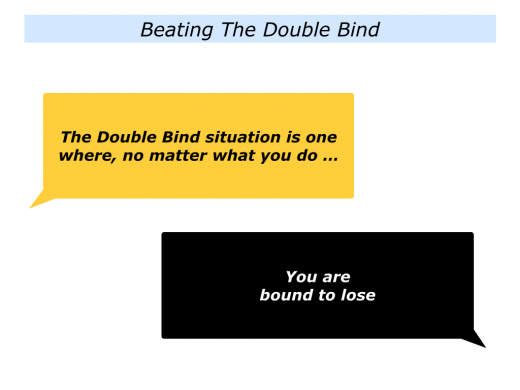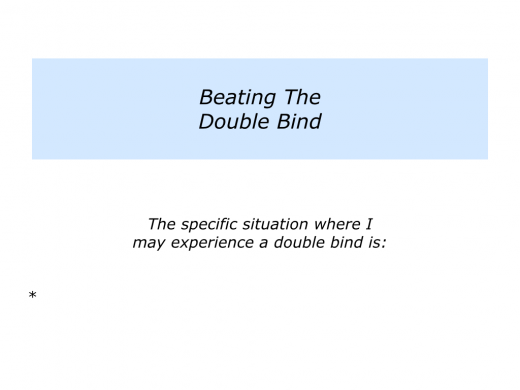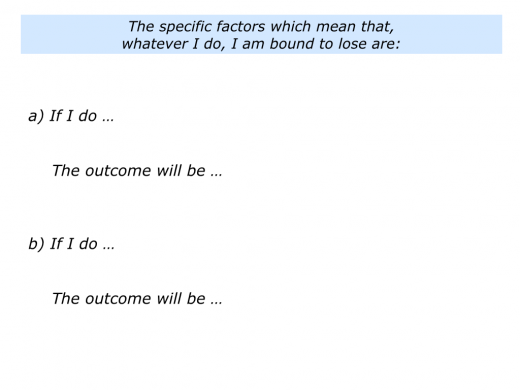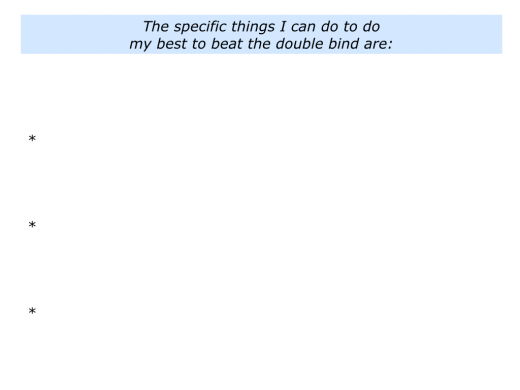Have you ever been in a double bind? This is a situation in which – no matter what you do – you seem bound to lose.
Double binds cause great pain in the family and at work. Here are three suggestions for overcoming such situations.
Recognising The Double Bind
A child used as a pawn between rowing parents, for example, will feel they cannot win. Here is the worst case scenario in a divorce.
The mother says to the child:
“If you love me more than your father, come to me.”
The father says:
“If you love me more than your mother, come to me.”
The child has an impossible choice. Showing favour to one parent will incur the wrath of the other. Both options are painful. Retreating into their private world is often their only salvation.
The adult who abuses a child puts their victim in a double bind. They may say something like the following.
“Nobody will believe you. They will believe me rather than you. Anyway, it was your fault. You led me on.”
The abuser presents themselves as the victim. This is another way of trying to put the abused person in a double bind. They also try to get the victim to doubt their own experience.
The abused person feels bad but may find it difficult to explain this to anybody. When running group sessions for survivors of abuse, for example, it is common to hear a person listen to other people’s stories and then say something like the following.
“That happened to me as well. I was told that it couldn’t be true and I started doubting my own feelings. Sometimes I felt as if I was going mad.”
Double binds can happen in our relationships at work. A strong signal that you are entering such territory is when you feel a knot in your stomach.
Something happened – either between you and a manager, in a meeting, or elsewhere – which makes you feel uneasy. Examining the situation in detail, you find that you have been placed in a position where, whatever you do, you are bound to lose.
Some people even put themselves in double binds. For example, they use 50% of their energy thinking of a positive way forward in their lives. They then employ the other 50% knocking it down by worrying about what can go wrong.
Confusing? Yes, but some people experience this inner dialogue. This becomes debilitating. They may then even start putting other people in double binds.
How to tackle this challenge? The first step is to recognise the double bind. Simply giving a name to it puts the situation outside yourself. You are not to blame and can move onto the next step.
Doing Your Best To
Beat The Double Bind
Clear contracting is the best way to untangle the double bind. Start by making a contract with yourself. You can focus on the following themes.
The Controllables
Clarify the specific things you can and can’t control in the situation.
The Dos And Don’ts
Clarify the specific things you do and don’t want to do in the situation.
The Action Plan
Clarify the action plan you want to follow and make a contract with yourself to follow it in the situation.
Imagine that you have spent lots of time encouraging a person but they choose to continue blaming the world for their troubles. They start conversations by saying something like the following.
“Why do things always happen to me? I feel so depressed, but when I try to talk about my problems, people walk away. You are the only person who takes the time to listen to me.”
This is a classic double bind. If you keep listening to the person you may feel depressed. You may also be enabling them to stay in their chosen role and keep saying “Yes, but.”
If you don’t listen to the person they may say that you, their final hope, does not care. This will confirm their view that the world is against them.
How to deal with such a situation? One approach may be to say something like the following.
“I am prepared to help, but only if you are prepared to look for solutions. You are intelligent and I am sure it is possible to find a way forwards.
“If you wish, take time to reflect. Then, when appropriate, get back to me when you are ready to focus on finding solutions. I will then do what I can to help.”
Be prepared for the person to go into the victim role. They may say something like.
“See, this confirms nobody understands and everything is against me. You were the last person I thought would desert me.”
Stand firm. Repeat that you would be happy to talk with them if they want to find solutions. This sound tough, but it is one way to move forward. The alternative is that you both end up feeling miserable.
If appropriate, you can try to make clear contracts with them about how you would like them to behave in the future. You can also outline the benefits both to themselves and other people.
Sometimes this approach works, but frequently it doesn’t. The people causing the pain are not open to win-wins. They are stuck in win-lose or lose-lose.
It may not be possible to solve everything straight away. When in doubt, however, choose the route forward that will, in the long term, cause the least pain.
Recognising Potential
Future Double Binds
Healthy people develop the radar to spot double binds when these appear on the horizon. They recognise that avoiding such pain can save lots of energy.
Looking ahead, can you think of a situation that may be a possible double bind? This could be in your personal or professional life. What may be the factors that make it a double bind? For example:
If I do (a) the outcomes won’t be good;
If I do (b) the outcome won’t be good.
Bearing these things in mind, how can you do your best to beat the double bind? Again, it may be useful to explore the following steps.
Describe what you can and can’t control in the situation.
Describe what you do and don’t want to do in the situation.
Describe your action plan and follow it in the situation.
When in doubt, try to avoid putting yourself in situations that are potential double binds. Prevention is better than cure.
Bearing this in mind, try to spot the potential double binds ahead of time. You can then, wherever possible, set up situations to succeed.
If you are going into such a situation, however, it may be useful to tackle the exercise on this theme. This invites you to complete the following sentences. Taking these steps can help you to stay healthy in a challenging situation.








Thank you for a wonderful post.
I particularly like the idea of giving bad behaviour a name.
This is the best most pragmatic advise I have seen on the subject. On top of that it is the best description of how to set boundaries i have seen in print. Excellent.
Very good and useful
als ein Anführer einer krim. Vereinigung